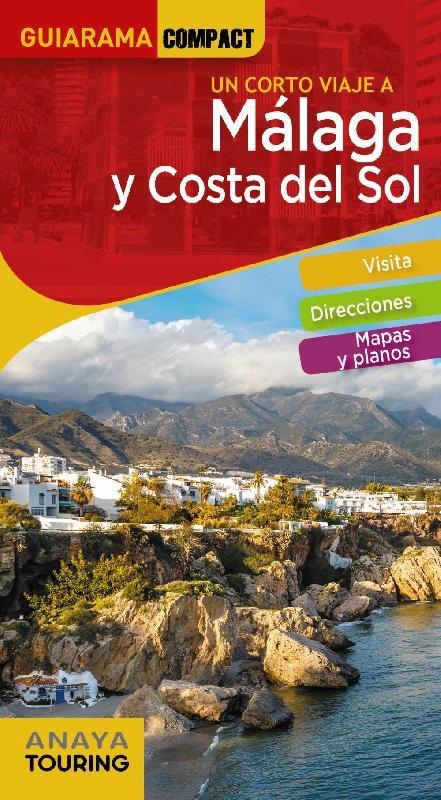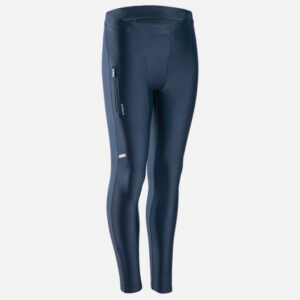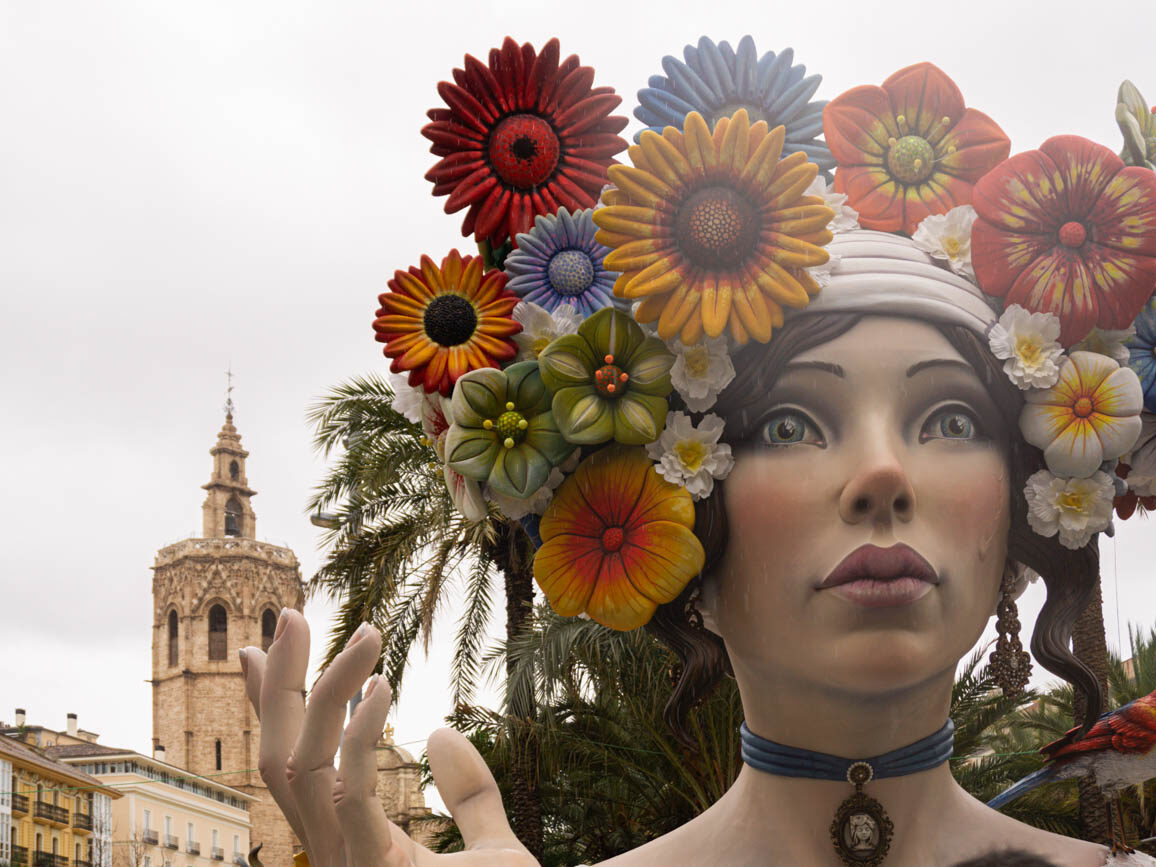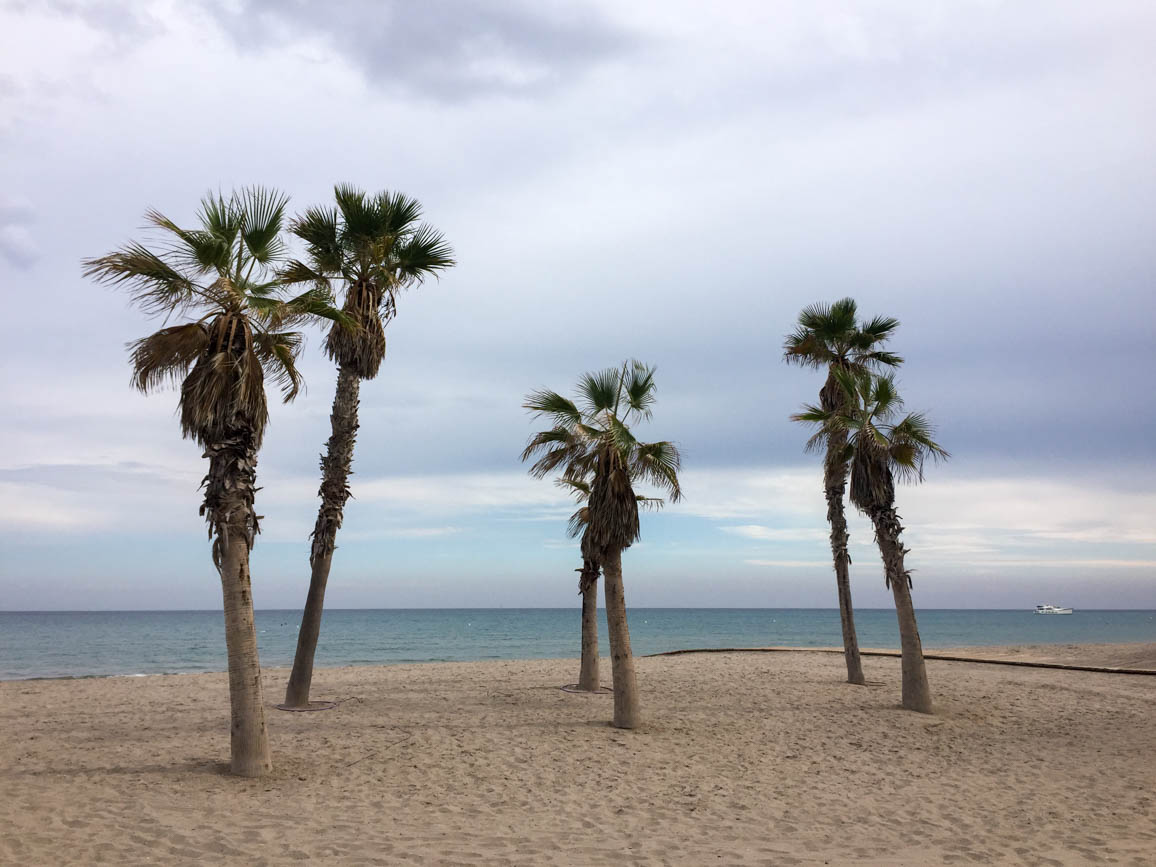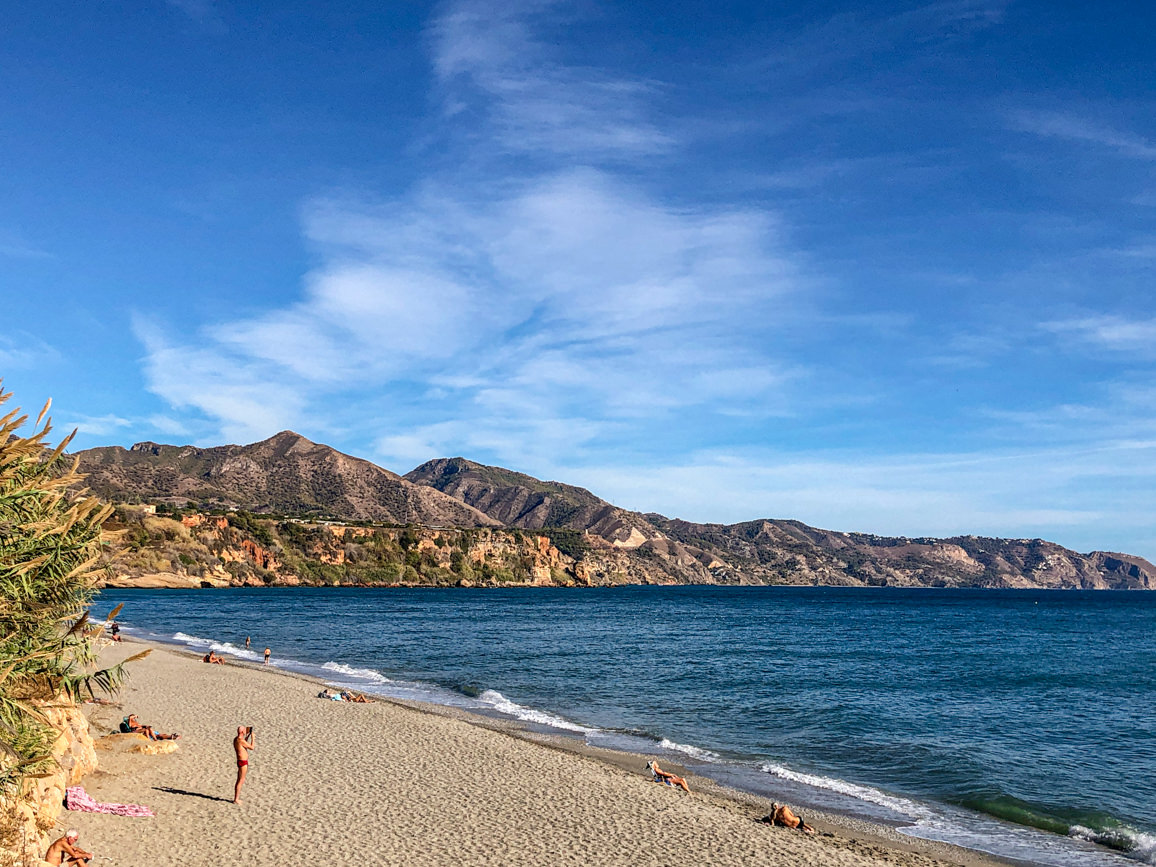
What to see in the Málaga province: 12 destinations inland & along Costa del Sol
The Málaga province ranks as a highly popular destination in southern Spain. In addition to the lively capital city of Málaga, the idyllic beaches along the Mediterranean Costa del Sol attract locals and tourists alike, while the whitewashed villages inland are also worth visiting given their charm. Are you ready to discover the twelve following locations?
Table of Contents
ToggleDisclaimers:
- I have visited the Málaga province various times over the years, the last one being in January 2024. This post includes the latest information available to this date, and I’ll keep updating it as I discover more destinations.
- Please note that this post includes some affiliate links. This means that, at no additional cost for you, I earn a commission if you make a purchase. In case you have any question about the companies advertised here or my status as an affiliate, please do not hesitate to contact me.
For your ease of reference, I’ve broken down this post with 12 destinations in the Malaga province into two main sections:
- Coastal towns along Costa del Sol,
- And the more tranquil, yet charming whitewashed villages in the countryside.
At the end of this post, you will also find a map with all the locations mentioned here along with some additional travel inspiration in the southern region of Andalusia and elsewhere in Spain.
Last but not least, before, during and at the end of this trip I used this Málaga and Costa del Sol travel guide by Anaya Touring to plan accordingly and make the most of it. I hope you’ll find it helpful too!
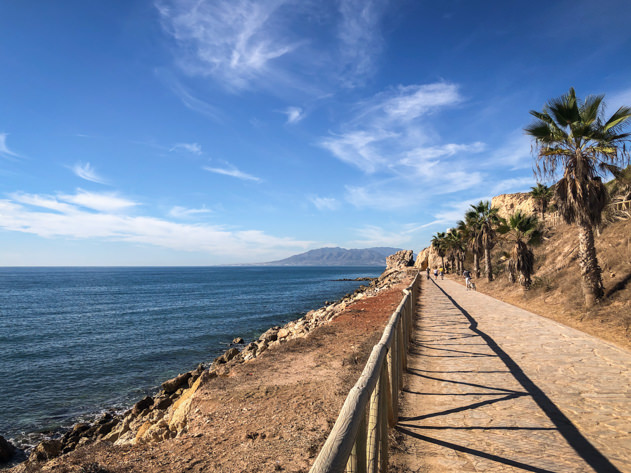
What to see along Costa del Sol, the sunny coastline in the Málaga province
Lying by the Mediterranean Sea, the popular Costa del Sol, literally meaning sunny coastline, covers more than 150 km of beaches in southern Spain, between the province of Malaga and the eastern area of the Campo de Gibraltar in Cádiz.
However, in this post, we will only be focusing on the coastal towns in the province of Málaga.
Heading east to west, these are the five destinations that I have visited along Costa del Sol. There are of course many more on my bucket list (including Cómpeta, Manilva or Torrox), but I will keep updating this list as I explore more places in the area.
Let us now turn to each of these coastal towns in more detail, and discover what to see in each one of them.
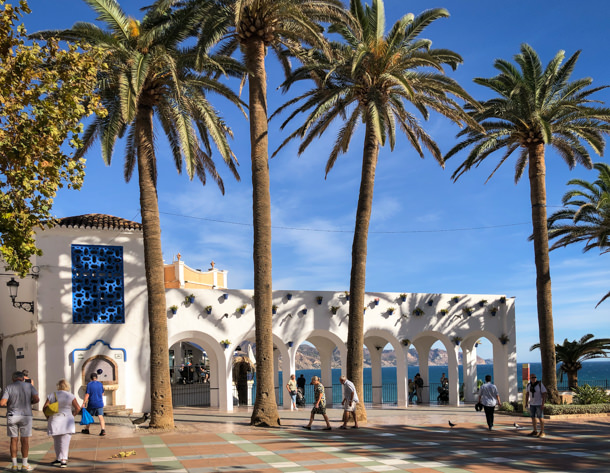
Nerja
Our first coastal town on the list of twelve destinations in the province of Malaga is Nerja. And honestly, I couldn’t think of a more spectacular location to start off this Andalusian itinerary!
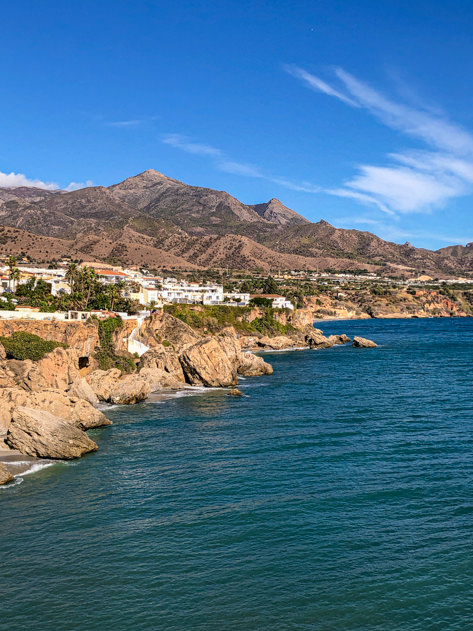
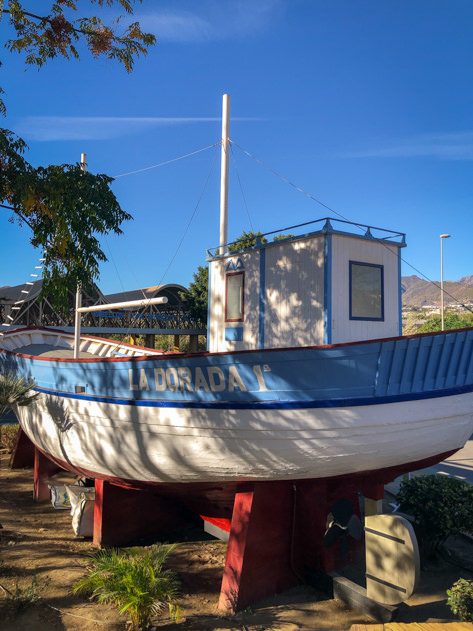
Located on a cliff overlooking the Mediterranean Sea, this seaside municipality that belongs to the Axarquía region is home to important prehistoric settlements, while preserving part of its primitive popular architecture, hence making it a popular tourist destination nowadays.
These are the top things to do in Nerja:
- Beaches: you will find a variety to choose from here, including Playa de Burriana, Carabeillo, Carabeo, El Chorrillo, Calahonda, El Salón, La Caletilla or La Torrecilla.
- Panoramic viewpoints: head to Balcón de Europa or to the nearby Mirador de Carabineros and Mirador de la Torrecilla for the best views of Nerja’s coastline and its surroundings. I loved the contrast between the rugged fierceness of its cliffs, the foamy waves, the golden sand and the green mountains in the distance. Truly breathtaking!
- Prehistoric site: a few kilometers inland from Nerja, in Maro, you can explore the famous Nerja caves (cueva de Nerja). You can actually get there by train from Nerja. This natural wonder features a vast network of caves housing delicate stalactites in its large rooms. You will also find interesting prehistoric paintings. During the summer months, it even holds a music festival! Other nearby attractions you can’t miss are an imposing aqueduct (Puente del Águila), the formidable Maro cliffs (acantilados de Maro-Cerro Gordo) or the emblematic waterfall (Cascada de Maro).
- Religious buildings: you can stop by a church built at the end of the 17th century (iglesia de El Salvador) or visit a hermitage (ermita de Nuestra Señora de las Angustias).
- Bonus: for my Spanish readers, did you know you can also pay a visit to Chanquete’s ship called La Dorada? This and other landmarks from the iconic ‘Verano Azul‘ television series come to life in Parque Verano Azul.
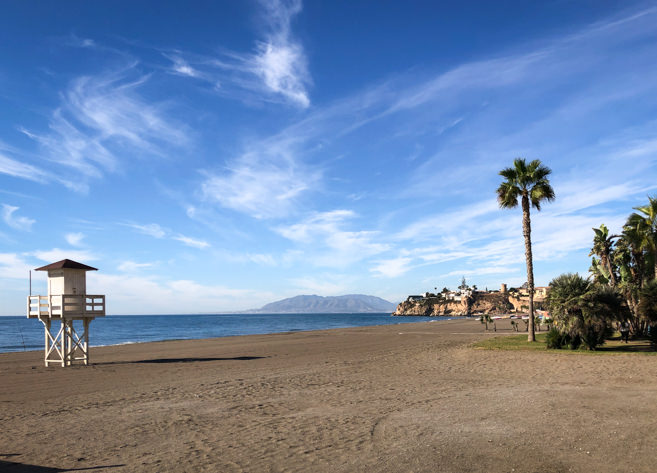
Rincón de la Victoria
Literally meaning ‘victory corner’, there’s nothing particularly exciting about Rincón de la Victoria (also simply referred to as ‘El Rincón‘), except that my Dad bought a house here and we’ve visited a few times now. 🙂
Jokes aside, Rincón de la Victoria also encompasses nearby Benagalbón, La Cala del Moral and Torre de Benagalbón. This municipality belongs to the Axarquía region.
One aspect that I particularly love about El Rincón is how close it is to Málaga: you can get there in just 25 mins by car, or even better, in around 45 mins by bike along the seaside promenade. Actually, the Coastal Path (Senda Litoral) is a 200km long boardwalk connecting all the coastal towns in the province of Malaga, from Nerja to Manilva.
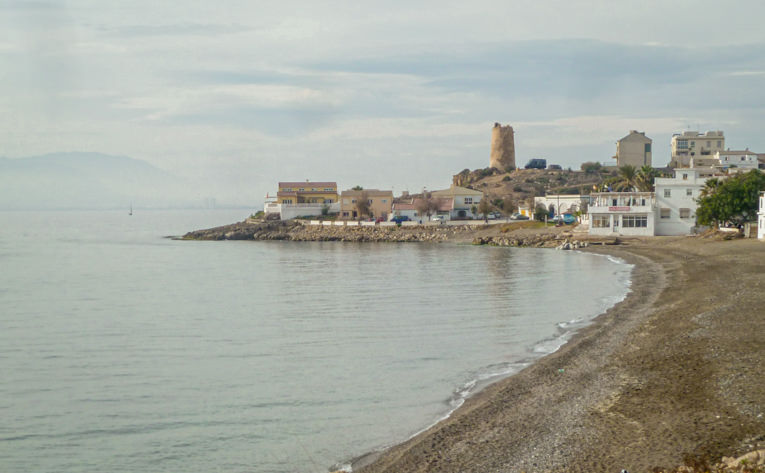
The main attractions in Rincón de la Victoria are the following:
- Nine kilometers of fine sand beaches, connected by a boardwalk and various tunnels, which replaced a former railway. This vast beach area is flanked by restaurants and beach bars (‘chiringuitos‘) serving delicious ‘espetos‘ of sardines and other local delicacies.
- An interpretation center and an archaeological park to learn more about the prehistoric caves in this area (cueva de la Araña, cueva de la Victoria, cueva del Tesoro – the last two feature cave paintings-). You will also find numerous lookout towers (called ´torres vigía‘ or ‘torres almenaras‘) along the coastline.
- A beautifully preserved Roman villa (Villa Antiopa) right by the Mediterranean Sea, in nearby Torre de Benagalbón.
- A sanctuary (Santuario de la Virgen del Carmen) between El Rincón de la Victoria and the nearby Cala del Moral. As in many coastal towns throughout Spain such as Barcelona or Hondarribia, there’s a yearly procession on July 16th to honor the patron saint of fishermen.
- A military fort built in the 19th century (Casa Fuerte Bezmiliana), now turned into an exhibition hall.
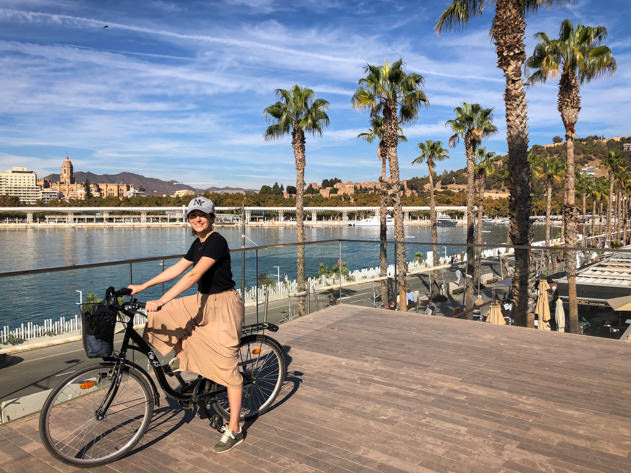
Málaga
Málaga is the capital of the homonymous province and the largest city in Costa del Sol, with almost 600,000 inhabitants.
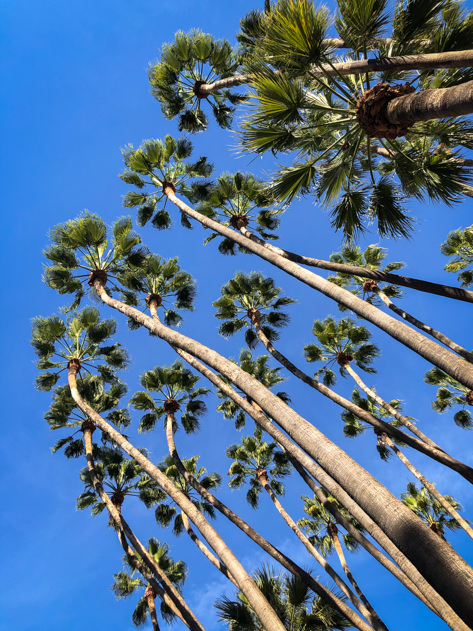

Some of the top sights in town include the Alcazaba, the Roman Theatre, the Cathedral and Calle Larios.
Malaga also hosts:
- Renowned museums such as the Picasso Museum or the Centre Pompidou Málaga;
- Verdant parks, gardens and idyllic beaches by the Mediterranean Sea;
- As well as other attractions off the beaten track like its imposing bullring or the Gibralfaro castle.
For an expanded version, read the Top things to do in Málaga, the capital of Costa del Sol (+ map), including what and where to eat, and where to stay.
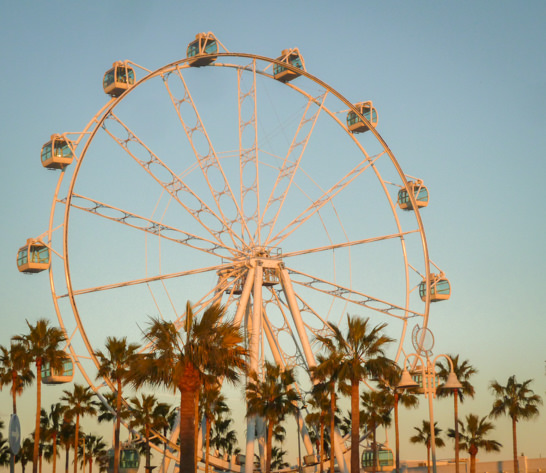
Benalmádena
Benalmádena includes the districts of Arroyo de la Miel and Benalmádena Costa, in addition to the town itself (Benalmádena Pueblo).
Let’s now delve into the top sights you can’t miss in Benalmádena, starting along the coast and heading up towards the mountains.
First, the area known as Benalmádena Costa has grown rapidly driven by the tourism boom in Costa del Sol. The main attraction here is called Puerto Marina, which is a vast complex housing luxurious boats, shopping galleries, restaurants and numerous nightlife venues. If you’re visiting Benalmadena with kids, you might want to go on the big wheel Mirador Princess. Alternatively, check out Sea Life with endless ocean creatures, or Selwo Marina, the perfect spot for dolphin, penguin and exotic species lovers!
Still along the coast, you will find various watchtowers (Torre del Muelle, Torrequebrada and Torre Bermeja), beaches (Playa de Fuente de la Salud, Malapesquera, Torre Bermeja, Cajón and Santa Ana), a casino (Casino Torrequebrada) and a golf course (Golf Torrequebrada).
Second, in Arroyo de la Miel, you can find the preserved ruins of a Roman arch that currently serves as the entrance to a building called ‘La Tribuna’. In the nearby square (Plaza de la Tribuna), there are also remains of an old mosque.
Heading left of Arroyo de la Miel, you could hop onto the cable car cabins (Teleférico de Benalmádena) for breathtaking panoramic views of the coastline while you ascend to Mount Calamorro. Once you’re up there, you may wish to hike any of the routes around the area. Otherwise, you can keep going west in order to explore the Butterfly Park (Mariposario de Benalmádena), an impressive Tibetan stupa or an intricate castle (Castilllo Monumento Colomares).
Finally, Benalmádena Pueblo lies at the top of a hill, next to the AP-7 highway. It still preserves some of its old charm as a whitewashed Andalusian town. The main site here is an interesting museum dedicated to Latin American artists (Museo de Arte Precolombino Felipe Orlando).
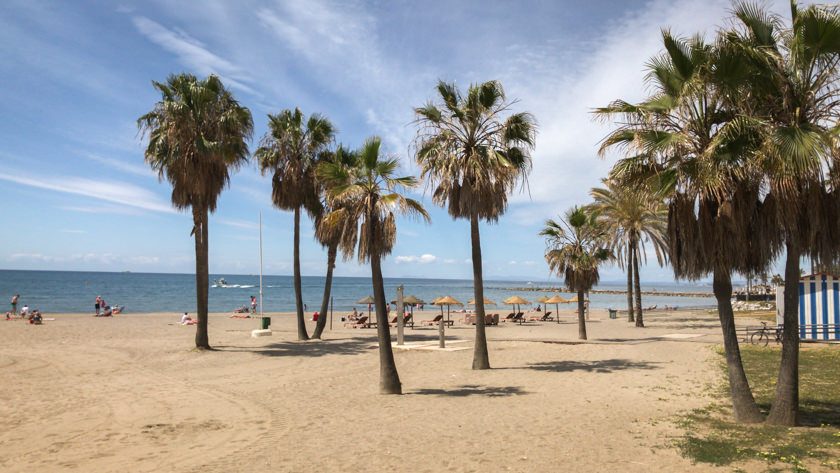
Marbella and Puerto Banús
Often associated with the rich and famous, Marbella is the ‘unofficial’ capital of the Costa del Sol. It became a tourist hotspot in the fifties thanks to its pleasant weather all year round, golden beaches, classy housing developments, and abundant golf courses.
Wondering what to see in Marbella?
I would suggest you start by strolling around Plaza de los Naranjos at the heart of the Old Town (centro histórico). Surrounding it you will find some historic buildings such as the City Hall built in 1568 (Ayuntamiento de Marbella), the former mayor’s house from 1552 (Casa del Corregidor, now turned into a restaurant), and a church (ermita de Santiago). The colorful flower pots and narrow whitewashed streets offer a picture-perfect introduction to Marbella! The nearby Plaza del Altamirano, flanked by the homonymous mansion, is especially lively during the summer nights thanks to its many bars ad restaurants.
If you want to travel back in time, note that there are numerous Roman remains such as a villa (Villa romana de Río Verde), baths (termas romanas de Las Bóvedas) and even a Paleo Christian basilica (Basílica Paleocristiana de Vega del Mar) in San Pedro de Alcántara. Some ruins of the city walls and an Arab castle have also stood up to this day.
Other religious buildings worth mentioning in Marbella include the following churches (iglesia del hospital de San Juan de Dios, iglesia de Santa María de la Encarnación), as well as a grandiose mosque (Gran Mezquita de Marbella).
Of course, the city of Marbella features renowned beaches (Playa de la Fontanilla, Venus, Guadalmina, Chapas or Artola, to name just a few). Enjoy some people-watching when strolling along the boardwalk! And don’t miss the watchtowers known as ‘almenaras‘ along the coast, namely Torre de las Bóvedas near the Roman baths, Torre Ancón, Torre Vigía Río Real, Torre de Lance de Las Cañas, and Torre Ladrones.
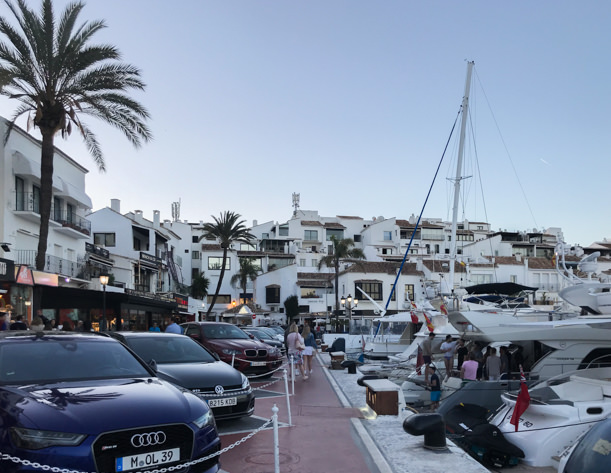
As a prime coastal resort, jet setters can pick from any of these four marinas: Puerto Deportivo Marina La Bajadilla, Puerto Deportivo de Marbella, Puerto de Cabopino, and finally the luxurious Puerto Banús all the way to the west. Actually, the 5-km strip known as Golden Mile runs from western Marbella to the heart of Puerto Banús, and it is one of the most exclusive areas.
In terms of shopping, feel free to explore the Puerto Banús flea market (‘mercadillo‘) running every Saturday morning next to the bullring. You could make interesting purchases from antique shops coming from Málaga, Ronda and Sevilla!
In case you’re more into culture, don’t fret as Marbella offers a wide range of museums from engraving to mechanics. Here’s a selection: Museo del Grabado Español Contemporáneo, Museo de Arte mecánico, Museo Ralli (displaying artwork from Latin American artists) or Centro Cultural Cortijo Miraflores.
Last but not least, you can finish off your visit to Marbella by heading to El Juanar, a former hunting refuge, to admire a beautiful panoramic view of the coastline. On a clear day, you may even see the famous Rock of Gibraltar and the African continent from here!
Feeling adventurous? Check out these Manawa activities in Marbella and around.
Buggy excursion to Istan and the reservoir of La Concepción from the Port of Marbella, Malaga
Canyoning at Guadalmina Gorge in Benahavís near Marbella
Dolphin Watching Boat Tour from Fuengirola, Malaga
Jet Ski Guided Excursion from Puerto Banús to Marbella, Málaga
Sailing trip on the Costa del Sol and Gibraltar from Sotogrande
Stand Up Paddle Rental in Playa de Nagüeles, Marbella
Tandem paragliding flight in Ronda, near Marbella
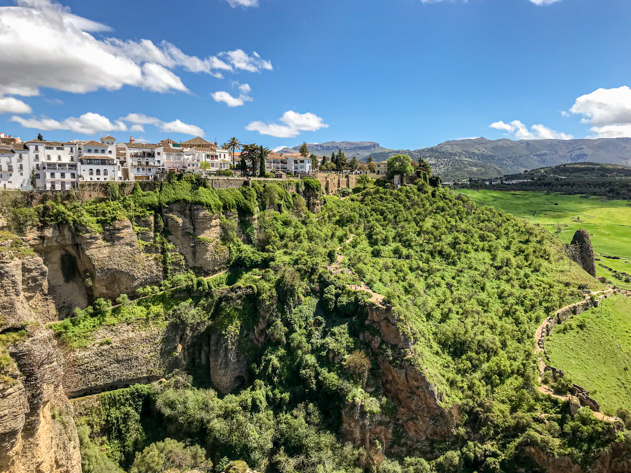
What to see inland the province of Málaga
Spain is famous worldwide for its amazing heritage, friendly locals and delicious food. In that sense, the province of Malaga is no exception, and flocks of tourists visit the sunny coastline known as Costa del Sol. However, it’s worth venturing to the countryside as well, where charming whitewashed villages and natural activities await.
For your ease of reference, I’ve picked the following seven countryside destinations in the province of Malaga; they are sorted alphabetically:
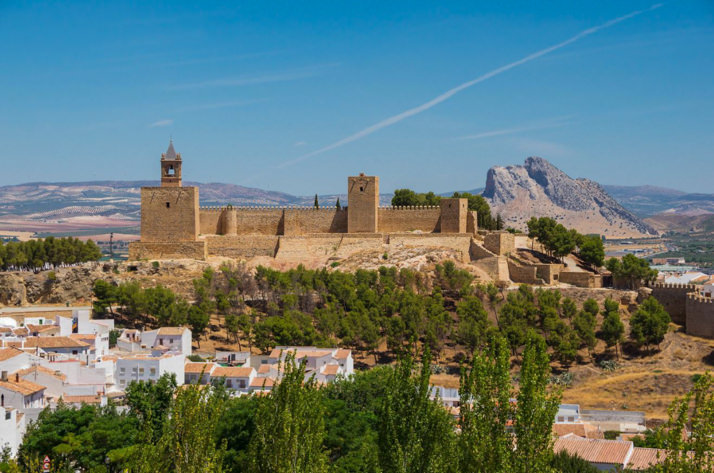
Antequera
Located at a crossroads, Antequera was called Antikaria during the Roman period. Later on, the city was invaded by the Moorish, who built a fortress (Alcazaba as in Granada or Málaga) and fortified walls, whose remains are still visible nowadays. However, Antequera reached its most glorious time between the 15th and 18th centuries. Most of the large religious and civil buildings were actually built during this period, making it one of the most monumental cities in Spain.
The highlights that you should cover during your visit to Antequera are the following:
- Arch of the Giants (Arco de los Gigantes): an imposing arch built in 1585.
- Religious buildings: Real Colegiata de Santa María la Mayor, Iglesia del Carmen, Iglesia de Nuestra Señora de los Remedios, Iglesia Colegial de San Sebastián, and Iglesia de Santa María de Jesús. You will also run into open chapels in the streets (such as Capilla Virgen del Socorro o del Portichuelo, or Oratorio de la Cruz Blanca).
- Manors and palaces (most of them were built in the 16th, 17th or 18th centuries): Palacio de las Escalonias, Palacio de los Marqueses de Villadarias, Casa del Conde de Pinofiel, or Palacio de Nájera, which houses the local museum.
- As in many other Spanish cities, there is also a bullring (Plaza de Toros de Antequera). Further places worth exploring include the Coso Viejo neighborhood, or Portichuelo square (Plaza del Portichuelo).
Last but not least, you can also visit two natural sites worth mentioning right outside Antequera: El Torcal, an impressive karst massif, and a set of three grandiose prehistoric dolmens (El Romeral, Menga,Viera).
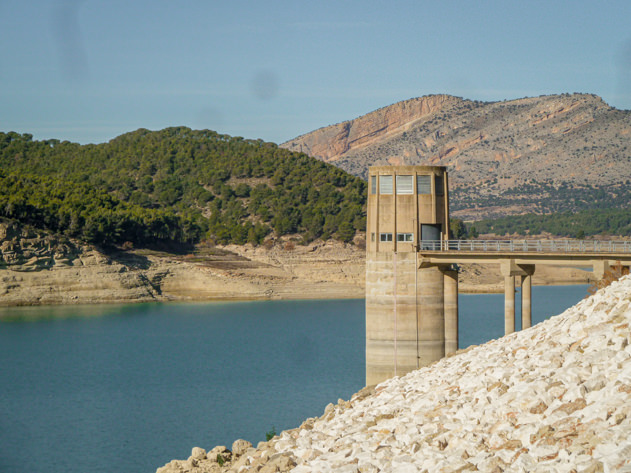
Ardales
For most travelers, Ardales is known for being the starting point of the famous ‘Caminito del Rey‘, which then continues south to the villages of Antequera and Álora. Literally meaning ‘the King’s little pathway’, this renowned hiking trail lies in a deep gorge amidst breathtaking landscapes. You will even be able to cross over a picturesque suspension bridge!
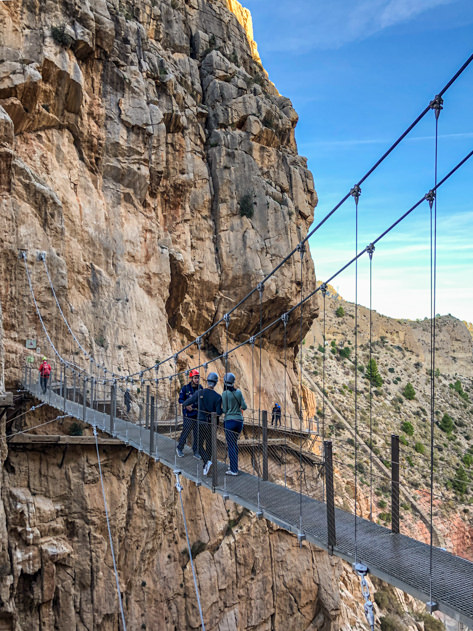
Do you love hiking? Then make sure to read my post about ‘El Caminito del Rey: the most popular hiking trail in Málaga‘.
In addition to hiking along ‘el Caminito del Rey‘, you may also explore the three reservoirs known as Los Tres Embalses. Namely, these are: Embalse Conde de Guadalhorce (also called ‘Pantano del Chorro‘), Embalse del Guadalhorce and Embalse del Guadalteba.
Other places worth visiting in Ardales include:
- Cueva de Ardales or Cuevas de Doña Trinidad Grund: they feature cave paintings from the Upper Paleolithic as well as impressive halls of stalactites, permanent lakes and unique rock formations. Definitely another must in Ardales!
- Bobastro archaelogical site, housing a Mozarabic basilica and other ruins dating from the late 9th and early 10th centuries.
- In the village of Ardales itself, you can check out the Municipal Museum that displays a prehistoric collection, the Roman bridge of La Molina from the 1st century, the remains of the 9th century Arab castle (castillo de Turón), or the church dedicated to Nuestra Señora de los Remedios (dating from the 15th century).
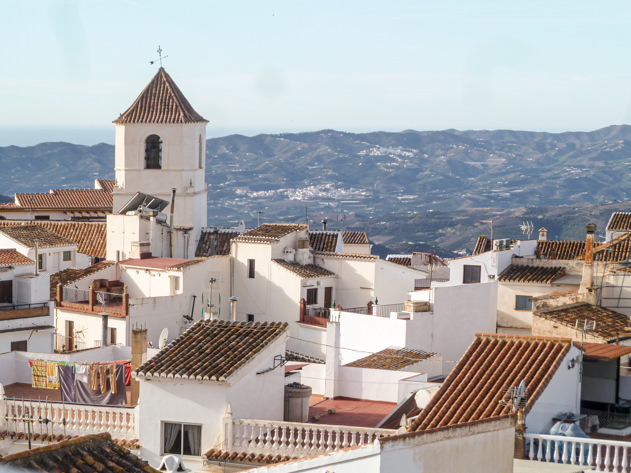
Canillas de Aceituno
Located in the Axarquía region, Canillas de Aceituno is a small village with an Arab origin. The main sightseeing highlights can be found around the City Hall (Plaza del Ayuntamiento), and they include:
- A church built on top of a mosque (Iglesia de Nuestra Señora del Rosario y San León Magno),
- A former building that was used to supervise the production and sale of mulberry leaves and silkworms (Casa de la Reina Mora),
- And various tanks from the medieval period (known as ‘aljibes‘): Aljibe Medieval, Fuente del Pilar Chico, and Fuente del Pilar Grande.

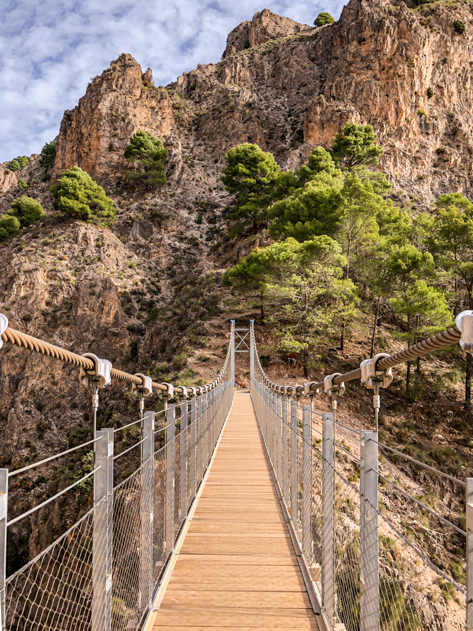
However, Canillas de Aceituno might be best known among nature lovers since stage 7 of the Great Malaga Path (Gran Senda de Málaga) connects this municipality with nearby Cómpeta. This trail bordering the canals offers beautiful views of the village, the surrounding mountains and the endless olive trees. Towards the end, ‘El Saltillo‘ bridge that crosses over a deep gorge deserves a special mention. You can also ascend to the highest peak in the province of Malaga (Pico de la Maroma, at 2.068 meters above sea level).
Read my post ‘El Saltillo: hiking the Gran Senda de Málaga from Canillas de Aceituno‘
Below are some of the sports products that I used when hiking in Canillas del Aceituno. Feel free to check out my Decathlon affiliate profile to create your own outfit.
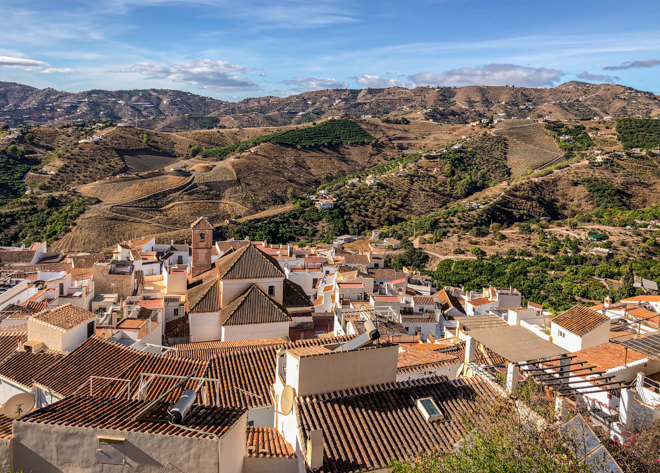
Frigiliana
Perched on a mountaintop, Frigiliana is one of the most beautiful whitewashed villages, not only in the Axarquía region, but also in the entire province of Málaga. It has preserved its original Moorish layout with steep and narrow streets. One of the best things you can do when visiting Frigiliana is wander around the cute shops and inns while waving locals. Soak up slow travel at its best!
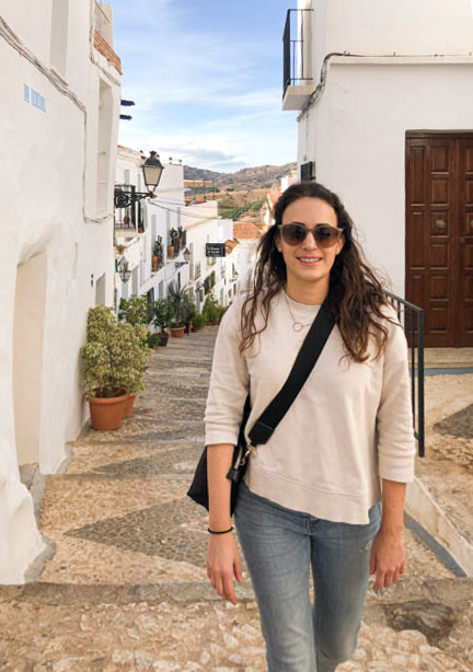
The following are some sites worth visiting in Frigiliana:
- Arab Castle of Lizar overlooking the village, although very little remains nowadays after its demolition in 1569,
- The Royal Granaries (Reales Pósitos) along calle Real that stored the surplus grain,
- The only sugar molasses factory that remains in Europe to this day, housed in a 16th century palace known as ‘El Ingenio‘ or Palacio de los Condes de Frigiliana,
- And a church built in the 17th century (Parroquia de San Antonio de Padua).
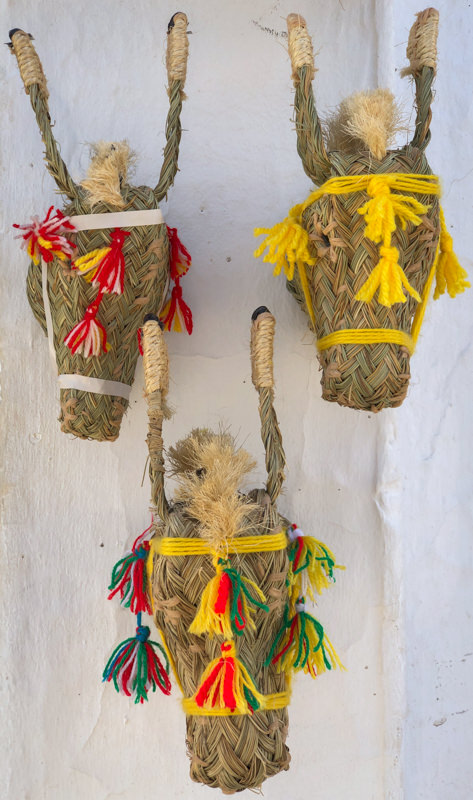
Mijas
When you think of Andalucía, Mijas is the stereotypical village that comes to mind with its narrow and steep streets featuring whitewashed houses. Thanks to its unique charm, a large part of its residents now originate from the United Kingdom!
Strategically located on a hill, Mijas can be divided in three distinct districts: Mijas Pueblo (that encompasses the village on top of the mountains), Mijas Costa (that borders the coastline and includes La Cala de Mijas, El Chaparral, El Combo and Calahonda), and Las Lagunas, a residential and commercial area.

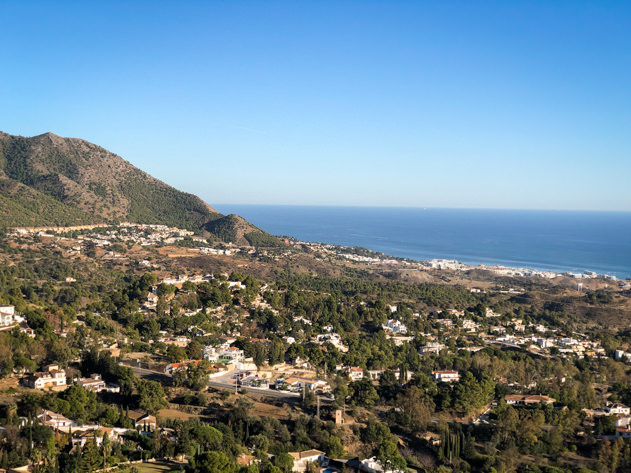
These are the main highlights that you can see and do when visiting Mijas Pueblo:
- Hop on the legendary donkey taxis (burros-taxi) for a ride through the streets of Mijas. The donkey taxi station can be found in Plaza Virgen de la Peña, near the City Hall and the Tourist Office. Even though these donkeys have truly become an institution, some animal defenders have pushed for banning this activity and a donkey sanctuary was even created to look after them. Alternatively, you can opt for a horse-drawn carriage ride or take a picture with the donkey statue next to the station.
- City Hall (Ayuntamiento) and the nearby hermitage (ermita de la Virgen de la Peña).
- Plaza de la Constitución: head to this square for a panoramic viewpoint of Mijas and the surrounding Costa del Sol from any of the numerous restaurants and bars!
- Carromato de Mijas: this curious museum displays miniature art.
- Bullring (Plaza de Toros): built in 1900, it features a singular oval shape.
- Discover the remains of a former tower (Torre de la Muralla) and walk along the city walls (Paseo de la Muralla) for more breathtaking views of the Mediterranean Sea.
- Don’t forget to stroll around the cute streets, where you will find plenty of local shops selling craft souvenirs such as leather or ceramic items.
If you’re a nature lover, the imposing mountain range (Sierra de Mijas) offers numerous hike and bike trail options to explore beyond Mijas.
Parauta
Located in the Ronda mountain range (Serranía de Ronda), the urban layout of Parauta with whitewashed houses along steep, narrow streets reflects its Moorish past.
Selected as one of the most beautiful Spanish villages in 2024, it has quickly become a tourist destination thanks to its famous enchanted forest (El Bosque Encantado). Local artist Diego Guerrero sculpted wooden figures representing fairies, elves and wizards throughout a 1km itinerary that connects Parauta and nearby Cartajima.
Nature lovers will also appreciate the centenary Valdecilla holm oak and the monumental Pinsapo de las Escaleretas, a Spanish fir that is four or five centuries old. They’re not magic, but they could easily be, who knows! 🙂
Finally, the chestnut grove known as El Bosque de Cobre is worth stopping by, especially during the fall season, when the leaves turn yellow, red and ochre.

Ronda
Ronda comes last on my list of destinations throughout the province of Malaga. It is considered the capital of the western interior of Malaga known as Serranía de Ronda. This mountaintop town is set dramatically above a 100-meter-deep gorge over the Guadalevín river known as ‘El Tajo‘. When visiting, make sure to add a lookout to your travel itinerary to enjoy unforgettable views!
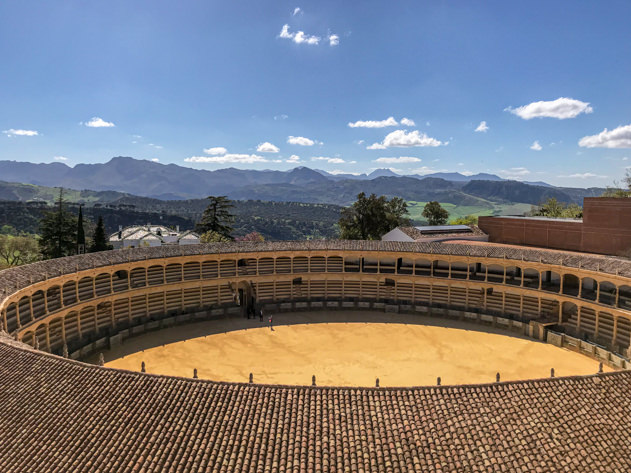
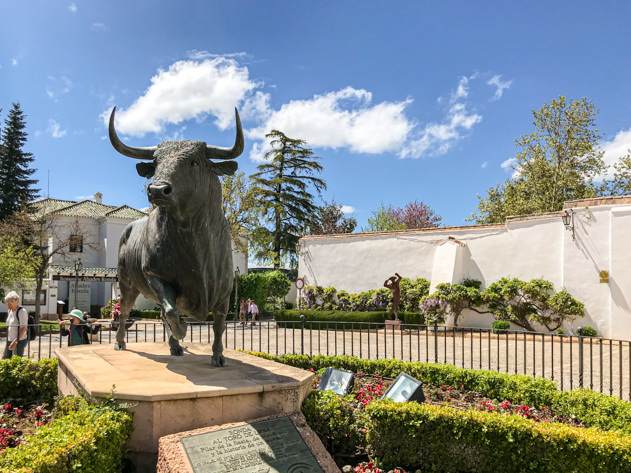
The city of Ronda can be divided into three well-differentiated parts: La Ciudad, El Mercadillo, and San Francisco.
The district known as ‘La Ciudad‘ houses the old town that dates back to Moorish rule. Its layout is still medieval and monumental, and this is where you will find the main attractions, including:
- Religious buildings: Colegiata de Santa María la Mayor, iglesia del Espíritu Santo, minaret of San Sebastián.
- Civil constructions: Casa-Palacio del Gigante (preserved mansion from the Nasrid dynasty), Palacio de Mondragón (now housing the municipal museum), Palacio del Marqués de Salvatierra, Casa Museo don Bosco, or the City Hall (Ayuntamiento).
- Remains of the Arab walls as well as imposing gates (Puerta de Almocábar, Puerta de Carlos V) and arches (Arco de Felipe V).
- Casa del Rey Moro: this mansion built in the 18th century houses two treasures. The first one is an Arab stairway to a water mine dating back to the 14th century (Escalera de la Mina), and the second are the delicate gardens overlooking the Tajo gorge.
- Museums: Museo Lara, the municipal museum located in the elegant Palacio de Mondragón, Casa Museo Don Bosco, Museo del bandolero (devoted to the renowned bandits that once abounded in this area of Andalucía), or the Unicaja Joaquín Peinado Museum dedicated to this local Cubist painter.

‘El Mercadillo‘ is the neighborhood located north of the gorge. It is linked to the old town by three bridges (Puente Viejo, Puente Árabe and Puente Nuevo). The latter was built in the 18th century, and has emerged as one of the symbols of Ronda. Other places worth referring to in this area include a shrine (Templete Virgen de los Dolores), the Arab baths, and the oldest bullring (Plaza de Toros de la Real Maestranza de Caballería de Ronda) in the country. Erected in 1785, this legendary bullring also houses a museum and the bullfight known as Corrida Goyesca every year in early September. You can actually enjoy a great view of the bullring from the nearby Hotel Catalonia rooftop!
Finally, the district of San Francisco was built south of the gorge. It once housed the Convent of San Francisco, which was destroyed by the French although a doorway is still preserved.
Should you wish to explore outside of Ronda, you can do so by heading to the Roman ruins of Acinipo, or to the rugged Natural Park of Sierra de las Nieves.

Map to follow my itinerary around the Málaga province
For an epic trip to this part of southern Spain, make sure to save the map below, as it includes all the locations mentioned throughout this post. The coastal towns along Costa del Sol are shown in blue, while the countryside destinations in the Malaga province appear in green.
More travel inspiration in Andalucía and across Spain
If visiting all these twelve destinations around the province of Malaga wasn’t enough…
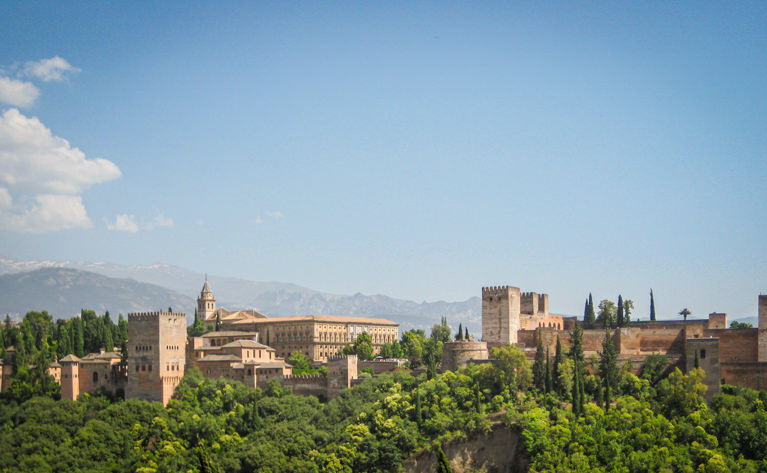
Read these posts for more inspiration around Andalucía!
A guide to the Feria de Abril in Sevilla
El Saltillo: hiking the Gran Senda de Málaga from Canillas de Aceituno
Granada travel guide: best things to see and do in 24 hours
Review of Hotel-Museo Patria Chica in Priego de Córdoba
The majestic beauty of Córdoba
Top things to do in Málaga, the capital of Costa del Sol (+ map)
Top things to do in Sierra de Aracena (Huelva): travel guide + map
And if you still want to discover more…
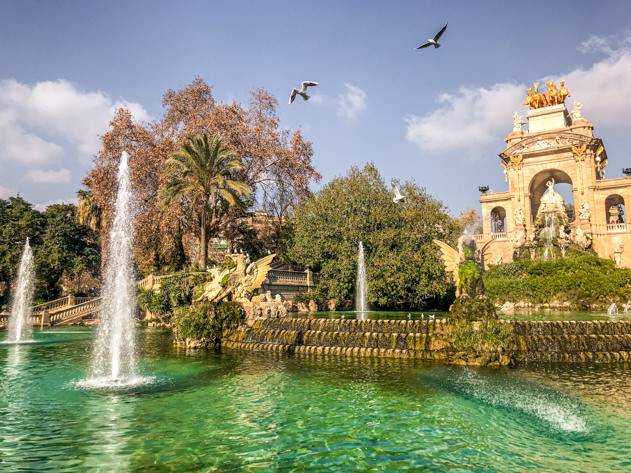
Visit my Spain page for more inspiring destinations around the country!
Camino de Santiago: hiking from Irún to Deba along the ‘Camino del Norte’
My top five museums to visit in Guipúzcoa
What to do around Salas de los Infantes (Burgos)
Where to eat and drink in Barcelona: my favorite spots (+map)
Are you planning to visit any of these twelve destinations in the Malaga province soon? If so, I truly hope that this post helped you plan your trip and inspired you. I’ll be happy to answer any questions or comments you may have. And in the meantime, have safe and happy travels!
| GET READY FOR YOUR NEXT TRIP! |
|---|
| Browse my travel resources to plan your upcoming trip. |
| Feeling adventurous? Book any outdoor activities worldwide with Manawa! |
| Get medical or health insurance via SafetyWing for extra peace of mind. |
| Looking for sports equipment? Feel free to browse my Decathlon profile for inspiration. |
| Use the Anaya Touring travel guides to plan your trip. They’re really comprehensive and helpful! |

